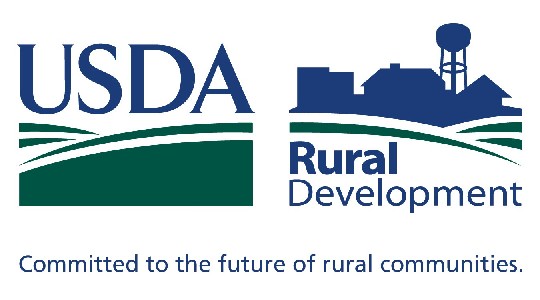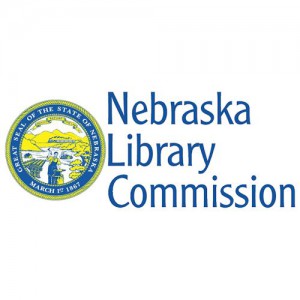Search the Blog
Categories
- Books & Reading
- Broadband Buzz
- Census
- Education & Training
- General
- Grants
- Information Resources
- Library Management
- Nebraska Center for the Book
- Nebraska Memories
- Now hiring @ your library
- Preservation
- Pretty Sweet Tech
- Programming
- Public Library Boards of Trustees
- Public Relations
- Talking Book & Braille Service (TBBS)
- Technology
- Uncategorized
- What's Up Doc / Govdocs
- Youth Services
Archives
Subscribe
Category Archives: Information Resources
NCompass Live: NebraskAccess Expansion
 Join us for next week’s NCompass Live, “NebraskAccess Expansion”, on Wednesday, June 17, 10:00-11:00 am Central Time.
Join us for next week’s NCompass Live, “NebraskAccess Expansion”, on Wednesday, June 17, 10:00-11:00 am Central Time.
Join us for an overview of the new NebraskAccess database lineup available as of July 1st. New EBSCO databases include MasterFILE Complete, Primary Search, NoveList Plus, MyHeritage, Points of View Reference Center, Small Business Reference Center and Psychology and Behavioral Sciences Collection. EBSCO also offers a new search interface, Explora, available for schools and public libraries that will be previewed. Options for online training and face-to-face training will also be discussed.
The Nebraska Library Commission pays for statewide subscriptions to these databases providing access to all Nebraska libraries and residents at no cost to them. In addition to being a portal for statewide databases, NebraskAccess offers topical listings of websites selected by librarians.
Presenters: Devra Dragos, Allana Novotny, and Susan Knisely; Nebraska Library Commission.
Upcoming NCompass Live events:
- June 24 – Metadata Manipulations: Using MarcEdit and Open Refine to Enhance Technical Services Workflows
- July 1 – Cardboard Conundrum: Why a Small University Library Has Grown a Monthly Board Game Night
- July 8 – Manage the Device Deluge
- July 22 – From the Basement to the West Wing: The Talking Book & Braille Service’s New Space
For more information, to register for NCompass Live, or to listen to recordings of past events, go to the NCompass Live webpage.
NCompass Live is broadcast live every Wednesday from 10am – 11am Central Time. Convert to your time zone on the Official U.S. Time website. The show is presented online using the GoToWebinar online meeting service. Before you attend a session, please see the NLC Online Sessions webpage for detailed information about GoToWebinar, including system requirements, firewall permissions, and equipment requirements for computer speakers and microphones.
Tracking fees have now been eliminated
Beginning June 1, 2015, Library Mail and Media mail packages sent through the U.S. Postal Service can be tracked for free, as the $1.05 per item tracking fee is being eliminated. All you need to do is ensure a barcoded USPS tracking label is affixed to your mailpiece. Delivery information can be obtained at www.usps.com (using the search box) or call toll-free 1-800-222-1811. Tracking labels can be ordered online at no charge in packs of 50 at this link.
Posted in General, Information Resources
Leave a comment
Focus on Nebraska authors: Stephanie Kallos
I became aware of Stephanie Kallos, an author with a Nebraska connection, when I served on the committee to help select One Book One Lincoln in 2006. Her first novel, Broken for You had been nominated and I was struck by the artful way Kallos spun multiple themes of brokenness, both overwhelming and subtle, together into one plot. The selection committee ranked it in the top 5 five of all the nominations and I successfully recommended it to a few of my friends after I finished.
Stephanie grew up in Lincoln and now resides in Seattle with her husband, two sons, a Labrador and two tabby cats and is currently working on her third novel. Broken for You was published in 2004 and was chosen by Sue Monk Kidd as a "Today Show" book club selection and received the Washington State and PNBA Book Awards. Her second novel, Sing Them Home, was published in 2009 and was selected as a January ’09 IndieNext title.
We own both of Kallos' titles in our book club collection so consider selecting this Nebraska author for your next book club read.
Posted in Books & Reading, General, Information Resources
Leave a comment
New State Agency Publications Received at the Library Commission
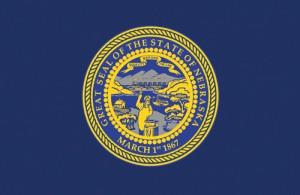 New state agency publications have been received at the Nebraska Library Commission for May 2015. Included are titles from Nebraska Department of Education, Nebraska Department of Health and Human Services, Nebraska Department of Labor, and University of Nebraska Press, to name a few.
New state agency publications have been received at the Nebraska Library Commission for May 2015. Included are titles from Nebraska Department of Education, Nebraska Department of Health and Human Services, Nebraska Department of Labor, and University of Nebraska Press, to name a few.
The Data Dude – The Power of the -1
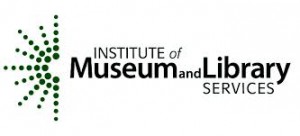 As some of you know, the Dude is working to clear up some of the questions that the Census folks have regarding our submitted public library survey data. You may have received a phone call or e-mail with questions about your survey. If you don’t care about the process, skip to the second paragraph below. If you do, read on. As a matter of explanation, IMLS (the Institute of Museum and Library Services) is the agency that oversees the public library survey. The U.S. Census Bureau is the agency that works for IMLS to collect the data. Individual libraries in Nebraska submit their survey data online via Bibliostat (there are other methods, but we use Bibliostat), between the middle of November and the middle of February. Bibliostat has edit checks built into the program to flag certain questions (e.g. if there was a large change from last year), and in order to pass the edit check you need to explain the differences in a note. Once your surveys are submitted, they are reviewed and you might be contacted by the Dude if there are additional questions. Once that is cleared up and all of the surveys are submitted, finalized, and locked, Bibliostat sends us the files of the compiled data and we submit them to Census. When the data goes to Census, there are additional edit checks (both critical and non-critical) that we must pass in order to submit the data. Once that occurs, Census looks over everything and then sends us another file with follow up questions. Generally, this is because there are inconsistencies in the notes that explain the inconsistencies in the data.
As some of you know, the Dude is working to clear up some of the questions that the Census folks have regarding our submitted public library survey data. You may have received a phone call or e-mail with questions about your survey. If you don’t care about the process, skip to the second paragraph below. If you do, read on. As a matter of explanation, IMLS (the Institute of Museum and Library Services) is the agency that oversees the public library survey. The U.S. Census Bureau is the agency that works for IMLS to collect the data. Individual libraries in Nebraska submit their survey data online via Bibliostat (there are other methods, but we use Bibliostat), between the middle of November and the middle of February. Bibliostat has edit checks built into the program to flag certain questions (e.g. if there was a large change from last year), and in order to pass the edit check you need to explain the differences in a note. Once your surveys are submitted, they are reviewed and you might be contacted by the Dude if there are additional questions. Once that is cleared up and all of the surveys are submitted, finalized, and locked, Bibliostat sends us the files of the compiled data and we submit them to Census. When the data goes to Census, there are additional edit checks (both critical and non-critical) that we must pass in order to submit the data. Once that occurs, Census looks over everything and then sends us another file with follow up questions. Generally, this is because there are inconsistencies in the notes that explain the inconsistencies in the data.
UPDATE: Throughout this process, you should be reminded of the codes that Bibliostat and Census use for data that is reported. Now, these codes are -3 (not applicable), -1 (not collected), and just plain ol’ 0. The Dude had previously reported using these codes in your surveys, but was recently told by Bibliostat that they prefer either N/A or 0. They then convert those entries to either -1’s or -3’s for the federal elements. The Dude does ask that for these you include a note indication “not collected” if the question is relevant but you just didn’t collect the data. Shaka.
The Data Dude – Integrated Library Systems
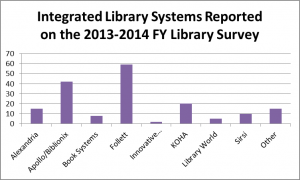 Today, the Dude regurgitates some statistics from last year’s survey (2013-2014) regarding integrated library systems. The leaders (see the chart at the right) are Follett, Apollo (Biblionix), and KOHA (Pioneer Consortium). It should be noted that library needs are different and while one ILS may work real well for one community, it may not be the best choice for another, even when other factors are similar. If you are interested in looking at the data about the ILS your peer libraries are using, you can download the excel file with all the data. Shaka.
Today, the Dude regurgitates some statistics from last year’s survey (2013-2014) regarding integrated library systems. The leaders (see the chart at the right) are Follett, Apollo (Biblionix), and KOHA (Pioneer Consortium). It should be noted that library needs are different and while one ILS may work real well for one community, it may not be the best choice for another, even when other factors are similar. If you are interested in looking at the data about the ILS your peer libraries are using, you can download the excel file with all the data. Shaka.
Small Business Administration: Get certified as an 8(a) Firm
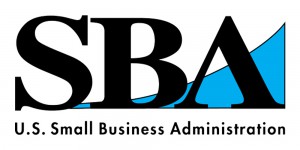 There’s a program that could give your business a big jump in snagging federal government contracts — and the SBA can help you take advantage of it.
There’s a program that could give your business a big jump in snagging federal government contracts — and the SBA can help you take advantage of it.
Why would you want to sell your great products and services to the biggest buyer in the entire world? Here’s eight reasons why getting certified as an 8(a) small business could mean big business.
- The federal government buys everything, from janitorial services to logistics support and everything in between, to the tune of more than $500 billion a year (that’s billion with a B)
- Did you know contracting agencies are required to set aside a certain percentage of all contracts to small businesses, including those with special socio-economic certifications? That gives you the chance to compete with larger contracting firms on a more equal basis.
- If you qualify, you can bid for sole-source contracts up to $4 million for your goods and services, and up to $6.5 million in contracts if you’re a manufacturer.
- You can team up with another business as a joint venture to bid on contracts, allowing you to get more lucrative jobs together as a prime contractor.
- Your business can team up with a more experienced prime contractor and have greater access to financing and successful bids under a Mentor-Protege agreement.
- You can get specialized business training, counseling, marketing assistance and high-level executive development from SBA’s resource partner help that other companies just can’t get.
- Get known to potential purchasers.
- And, by getting certified as an 8(a) firm, you’ll be eligible to buy surplus government property, like desks, computers, tractors, heavy equipment and more, at the same price as government agencies can.
Come learn to see if you qualify, how to apply and leverage your certification.
Sign up now for SBA Certifications: 8(a), Hubzone and ED/WOSB
May 27, 9:30-11:30 a.m.
SBA Nebraska District Office, 10675 Bedford Ave., Suite 100, Omaha
They’ll briefly cover the SBA’s other certification programs, EDWOSB and HUBZone, in addition to the 8(a) program. You will learn:
- Program Details
- Eligibility Requirements
- Benefits
- SBA Assistance to 8(a) firms
- Application process.
Register online at the SBA Event Calendar.
Looking for Library Building Grants? USDA to Give Priority Funding for Regional Economic Development Projects
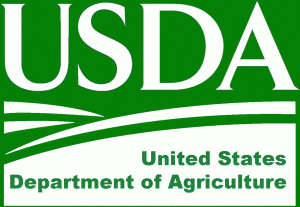 Agriculture Secretary Tom Vilsack announced yesterday the USDA’s plan to implement a Farm Bill provision that will have a major policy impact on the way the Department helps rural communities plan and finance regional economic development strategies. The new Regional Development Priority (RDP) policy will make it easier for rural communities to access resources to invest in long-term community development efforts by giving priority to applications for Rural Development programs that include regional partnerships and strategies.
Agriculture Secretary Tom Vilsack announced yesterday the USDA’s plan to implement a Farm Bill provision that will have a major policy impact on the way the Department helps rural communities plan and finance regional economic development strategies. The new Regional Development Priority (RDP) policy will make it easier for rural communities to access resources to invest in long-term community development efforts by giving priority to applications for Rural Development programs that include regional partnerships and strategies.
“Regional planning maximizes the effectiveness of our investments in rural America,” Vilsack said here today while addressing the 10th Annual Organization for Economic Cooperation and Development (OECD) Conference. “When communities come together to share resources, ideas and expertise, they can develop a cohesive economy strategy and invest in their future. With a strategy in place, USDA-funded projects can spur regional economic transformation, increase job opportunities and improve quality of life for rural communities.”
Under the RDP, communities with multi-jurisdictional economic development plans will be able to request funding priority when they apply for loans and grants in four key USDA programs. These programs help finance a variety of infrastructure, business and community development needs. They are:
- Community Facilities Program (look for library building grants here)
- Business & Industry Loan Guarantee Program
- Water and Environmental Program and
- Rural Business Development Grant Program.
Applicants seeking priority consideration will be judged by (1) how well their funding request supports a region’s existing development plan, and (2) how well the plan addresses regional collaboration and considers other funding sources including philanthropic groups and other federal agencies. Projects that receive funding will be based on locally identified needs and growth strategies that capitalize upon a region’s unique strengths.
Vilsack made this announcement during the 10th Annual Organization for Economic Cooperation and Development Conference in Memphis, Tenn. The conference brings world leaders and policy officials from 34 countries to discuss how modern policies can help rural regions reach their full economic potential, support national growth and be globally competitive. During the conference, Secretary Vilsack reaffirmed his vision for four pillars of rural economic development.
Additional information about the funding priority was published in today’s Federal Register.
Congress authorized USDA to implement this regional approach when it passed the 2014 Farm Bill. That law builds on historic economic gains in rural America over the past six years while achieving meaningful reform and billions of dollars in savings for taxpayers.
Since the bill’s enactment, USDA has made significant progress to implement each provision of this critical legislation, including expanding access to rural credit, developing new markets for rural-made products, and investing in infrastructure, housing and community facilities to help improve the quality of life in rural America. For more information, visit www.usda.gov/farmbill.
Webinar from Health Happens in Libraries: Launching Community Conversations with Local Health Data
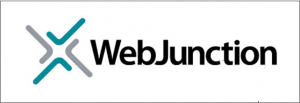 Join this webinar to learn how to build awareness, partnerships and services in support of community health, using County Health Rankings & Roadmaps data and networks.
Join this webinar to learn how to build awareness, partnerships and services in support of community health, using County Health Rankings & Roadmaps data and networks.
Community health data is a powerful tool. It allows public library leaders and local partners to launch conversations and prioritize activities to support community members with reliable health information and services. The County Health Rankings & Roadmaps program provides a comprehensive platform for community based organizations of all kinds to examine and take action on community health data. Attendees at this webinar will learn about ways in which cross-sector collaboration can positively influence social and environmental factors that impact community health. Attendees will also gain familiarity with key features of the County Health Rankings & Roadmaps tool for further exploration of these topics. Attendees will also learn how Buffalo & Erie County Public Library has built awareness, partnerships and services in support of community health, using local data and networks.
Date: 11 June 2015
Time: 2:00 PM – 3:00 PM Eastern Daylight Time, North America
Presenters:
- Kate Konkle, Community Coach, County Health Rankings & Roadmaps and
- Renee Masters, Information Services/Outreach Librarian, Buffalo & Erie County Public Library
Moderated by: Liz Morris, WebJunction
SBA LINC: Help to Access Capital
 There is a demand among entrepreneurs to find financing to get their businesses off the ground or to take the next big step in their expansion plan. Across the country, thousands of small businesses are searching for term loans, equipment financing, lines of credit, invoice financing and real estate loans to help them hire and grow.
There is a demand among entrepreneurs to find financing to get their businesses off the ground or to take the next big step in their expansion plan. Across the country, thousands of small businesses are searching for term loans, equipment financing, lines of credit, invoice financing and real estate loans to help them hire and grow.
This is where technology steps in to meet the demand. Online matchmaking services pairing lenders with prospective borrowers already comprise a multibillion dollar industry. Using the power of the Internet, commercial lenders are finding creditworthy small business borrowers, while entrepreneurs are finding loan officers who are ready to talk with them.
The U.S. Small Business Administration (SBA) is implementing this same matchmaking concept for SBA loan applications. Recently SBA Administrator Maria Contreras-Sweet announced a new SBA initiative called LINC (Leveraging Information and Networks to Access Capital). This SBA matchmaking service will help entrepreneurs connect with a lender.
The SBA spent months surveying their lending partners to discern what information they need from a prospective borrower. They have developed a simple online form with 20 questions that takes just minutes to fill out. Once completed, the form is blasted out to participating SBA lenders in an applicant’s county, as well as financial institutions with a statewide or national reach.
While a positive “hit” won’t ensure entrepreneurs will receive a loan, it will put them on a fast track because they have been pre-screened. If LINC doesn’t produce an immediate match, entrepreneurs will be directed to their local SBA adviser for additional assistance with their loan application.
The LINC matchmaking tool constitutes a huge step toward giving small business entrepreneurs access to essential sources of capital in all 50 states and the U.S. territories.
SBA is committed to becoming as innovative as the small businesses we serve. In the longer term, they also believe LINC could be modified to facilitate government contracting by connecting eligible small businesses with procurement officers, prime contractors and federal buyers. The future is now, and the SBA is proud to embrace technology to help small businesses access the capital they need to stay strong and dream big.
How to Set Up a Citizenship Corner at Your Library
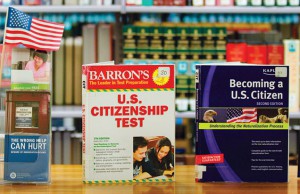 Libraries play an important role in raising awareness about the naturalization process and the rights and responsibilities of U.S. citizenship.
Libraries play an important role in raising awareness about the naturalization process and the rights and responsibilities of U.S. citizenship.
Create a dedicated space in your library where immigrants can find information about becoming a U.S. citizen. USCIS has developed educational materials to help prepare individuals for naturalization. These materials are ideal for setting up a Citizenship Corner in your library. Here immigrants can find the information and resources they need to start the path toward becoming a U.S. citizen.
A typical Citizenship Corner includes citizenship test preparation materials along with information about the naturalization process. Libraries can also add information about community resources, English teaching materials, and other relevant books and videos from their collections. While there are a number of immigration topics that may be of interest to libraries and their customers, USCIS recommends displaying only citizenship and naturalization-related resources in the Citizenship Corner.
How to Set Up a Citizenship Corner at Your Library
- Order one free copy of the USCIS Civics and Citizenship Toolkit. The Toolkit contains immigration and civics publications, handbooks, and multimedia tools. Additional copies are available for purchase through the U.S. Government Printing Office.
- Build your collection by purchasing other USCIS materials. Most of the following publications are also included in the Civics and Citizenship Toolkit:
- The USCIS Naturalization Interview and Test video
- Learn About the United States: Quick Civics Lessons for the Naturalization Test
- Vocabulary Flash Cards for the Naturalization Test
- Civics Flash Cards for the Naturalization Test (English and Spanish)
- Civics and Citizenship Multimedia Presentation
- Download Form N-400, Application for Naturalization and provide copies in the Citizenship Corner. (Remind your customers that all USCIS forms are free.)
- Display and distribute free USCIS informational resources:
- Print 11″ x 17″ citizenship awareness posters in English, Chinese, Spanish, and Vietnamese. Display these posters in the Citizenship Corner, classrooms, and other visible areas.
- Print 6″ x 9″ informational flyers in English, Chinese, Spanish, and Vietnamese. These flyers highlight naturalization eligibility requirements and resources available on the USCIS Citizenship Resource Center.
- Download and distribute the brochure 10 Steps to Naturalization: Understanding the Process of Becoming a U.S. Citizen.
- Download and display the Pathway to U.S. Citizenship poster.
- Enhance your Citizenship Corner with other citizenship-related and English as a Second Language (ESL) resources from your library’s collection:
- Locate the Citizenship Corner near ESL textbooks and resources or post signs directing customers.
- Feature books and magazines that address the content of the 100 civics questions on the naturalization test such as famous Americans, historical events, and important founding documents.
- Arrange your Citizenship Corner to be welcoming and helpful. Here are some additional suggestions:
- Decorate the Citizenship Corner in a patriotic theme.
- Distribute promotional flyers for citizenship or ESL classes offered at your library.
- Distribute flyers from local BIA-recognized organizations that may be able to help immigrant customers with USCIS forms. Visit uscis.gov for more information on finding legal services and BIA-recognized organizations.
- Create and distribute a referral list of local community organizations that provide citizenship services and ESL classes in your community. Start by visiting the Find Help in Your Community page on the USCIS Citizenship Resource Center. Another resource for finding community organizations that offer ESL, civics, and citizenship education classes is America’s Literacy Directory. Search for programs by zip code.
- Add computers to the Citizenship Corner and set the Internet browser home page to www.uscis.gov/citizenship, a one-stop USCIS resource for locating citizenship preparation materials and activities.
- Set up a video monitor at the Citizenship Corner and play The USCIS Naturalization Interview and Test video on a continuous loop.
- Set up a computer workstation that displays Preparing for the Oath: U.S. History and Civics for Citizenship. This interactive website highlights museum objects from the Smithsonian Institution to help people prepare for the civics portion of the naturalization test.
- USCIS often hosts naturalization information sessions and administrative naturalization ceremonies in libraries. View the list of upcoming naturalization information sessions at libraries nationwide. Contact your local USCIS Community Relations Officer if you are interested in USCIS hosting a similar session at your library.
- Create a virtual Citizenship Corner on your library website:
- USCIS offers many free web resources in the Learners section of this site. You may want to add a link on your website.
- Link to USCIS resources by adding a widget to your website. The widgets are small online applications in English and Spanish that can be embedded on social media sites, blogs, or other web pages.
- You can also include information about immigration and citizenship resources available at your library.
The Data Dude – Public Libraries and Hispanics
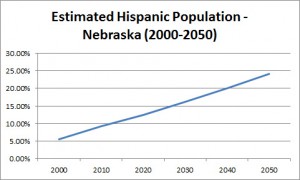 Shaka. Pew Internet research recently released a report about Public Libraries and Hispanics. If you have a large or increasing Spanish speaking constituency that your library serves, perhaps you might want a closer in-depth look at the Pew report. The report is important because the Hispanic population in Nebraska has grown, and is projected to continue to rise (see the chart at the right—sources: U.S. Census and UNO Center for Public Affairs Research). The increasing Latino/Latina population underscores the need for Spanish language materials (more than half of immigrant Hispanics are Spanish-dominant speakers). Interestingly, immigrant Latinos also are more likely to prefer audio and video over print book reading (32% v.s. 18% of whites). Also, Latinos are more likely to view library closings as having a major impact on their families and communities (40% v.s. 26% for whites). How many libraries have collection development policies specifically addressing materials in languages other than English? I’d venture to say a number have a version of these already. Perhaps it is time to review those, and plan for the future.
Shaka. Pew Internet research recently released a report about Public Libraries and Hispanics. If you have a large or increasing Spanish speaking constituency that your library serves, perhaps you might want a closer in-depth look at the Pew report. The report is important because the Hispanic population in Nebraska has grown, and is projected to continue to rise (see the chart at the right—sources: U.S. Census and UNO Center for Public Affairs Research). The increasing Latino/Latina population underscores the need for Spanish language materials (more than half of immigrant Hispanics are Spanish-dominant speakers). Interestingly, immigrant Latinos also are more likely to prefer audio and video over print book reading (32% v.s. 18% of whites). Also, Latinos are more likely to view library closings as having a major impact on their families and communities (40% v.s. 26% for whites). How many libraries have collection development policies specifically addressing materials in languages other than English? I’d venture to say a number have a version of these already. Perhaps it is time to review those, and plan for the future.
Nebraska USDA Rural Development Announces Funds Available for Low Interest Home Repair Loans and Grants
The U.S. Department of Agriculture Rural Development has announced adequate funding remains available to assist very low income households with home repairs. For those who own and occupy homes in need of essential repairs and who are wondering how to get financing, USDA Rural Development can help with grants and low-interest loans for homeowners in rural communities. All communities in Nebraska are eligible for housing programs with the exceptions of Fremont, Grand Island, Hastings, Kearney, Lincoln, North Platte, Omaha and South Sioux City/Dakota City.
Applicants must own and occupy the home and not exceed income guidelines established by county and household size. The family’s income must below 50 percent of the county median income. For many counties in Nebraska, the income limit for a one person household is $21,350; two person, $24,400; three person, $27,450; four person, $30,500 and five person, $32,950. However, some counties may have higher income limits. Please contact your USDA Rural Development office for the details in your county.
Available Low-interest Loans:
Rural Development’s Home Repair Loan program offers low-interest (1 percent) loans, up to $20,000, to very low income rural homeowners. Loans may be used to repair, improve or modernize homes or to remove health and safety hazards. Homeowners must meet household income guidelines, have an acceptable credit history and show repayment ability for the loan based on a household budget.
The USDA repair loan may be made up to $20,000 at a 1% interest rate, with a repayment term up to 20 years. Loans of less than $7,500 may not require a mortgage against the property. The low interest rate and extended terms of the loan make repayment more affordable for households with limited income. For example, a $10,000 loan at 1% interest for 20 years would have a monthly payment of $46, compared to a conventional loan with an interest rate of 5% for 10 years, with a monthly payment of $106.
Available Grants:
Rural Development’s Home Repair Grant program is available to owner-occupants of a rural home, who are 62 years of age or older, are very low income and are unable to repay a loan. Grant funds may only be used to remove health and safety hazards, such as replacing a roof, electrical and plumbing repairs, sanitary disposal systems and accommodations to make the home handicap accessible. Maximum lifetime grant assistance is $7,500.
Eligibility for the program is based on household income and applicants must be unable to repay a loan. If applicants can repay part, but not all of the costs, applicants may be offered a loan and grant combination.
For more information, go to the Nebraska RD website at http://www.rd.usda.gov/ne. You may also contact Single Family Housing Specialist Krista Mettscher at 402-437-5518, krista.mettscher@ne.usda.gov
President Obama’s plan for rural America has brought about historic investment and resulted in stronger rural communities. Under the President’s leadership, these investments in housing, community facilities, businesses and infrastructure have empowered rural America to continue leading the way – strengthening America’s economy, small towns and rural communities. USDA’s investments in rural communities support the rural way of life that stands as the backbone of our American values.
Helping people stay in their home and keep it in good repair helps families and their communities. Households interested in affordable home improvements may contact their local USDA Rural Development office or visit the Agency website at www.rd.usda.gov/ne for additional information.
USDA is an equal opportunity provider and employer. To file a complaint of discrimination, write: USDA, Office of the Assistant Secretary for Civil Rights, Office of Adjudication, 1400 Independence Ave., SW, Washington, DC 20250-9410 or call (866) 632-9992 (Toll-free Customer Service), (800) 877-8339 (Local or Federal relay), (866) 377-8642 (Relay voice users)
The Data Dude on Smartphone Use
 This week, the Dude takes a look at a recent Pew Internet report on smartphone use. First, let’s first not assume everyone knows what is generally meant when referring to a smartphone. A smartphone (or smart phone, if you prefer), is a device that functions as a phone (you can call or send text messages to other dudes) but also has additional capabilities. For example, it allows a person to browse the web, take photos and video with its camera, GPS navigation, and run a whole host of additional apps and games, either online or offline. Smartphones have various sized touchscreens. While these devices provide the user with the capability to get online with Wi-Fi (if available), most also allow mobile web use if you pay for a plan that has it (such as 4G) when you aren’t near a place that has Wi-Fi.
This week, the Dude takes a look at a recent Pew Internet report on smartphone use. First, let’s first not assume everyone knows what is generally meant when referring to a smartphone. A smartphone (or smart phone, if you prefer), is a device that functions as a phone (you can call or send text messages to other dudes) but also has additional capabilities. For example, it allows a person to browse the web, take photos and video with its camera, GPS navigation, and run a whole host of additional apps and games, either online or offline. Smartphones have various sized touchscreens. While these devices provide the user with the capability to get online with Wi-Fi (if available), most also allow mobile web use if you pay for a plan that has it (such as 4G) when you aren’t near a place that has Wi-Fi.
OK, so here are some facts from the report:
- Nearly two-thirds of all Americans now own a smartphone
- 10% of Americans that own a smartphone do not have any other form of high-speed internet access at home beyond their phone’s data plan
- 62% of smartphone owners have used their phone in the past year to look up information about a health condition.
- 57% have used their phone to do online banking.
- 44% have used their phone to look up real estate listings or other information about a place to live.
- 43% to look up information about a job.
- 40% to look up government services or information.
- 30% to take a class or get educational content.
- 18% to submit a job application.
- 56% use their phone at least occasionally to learn about community events or activities, with 18% doing this “frequently.”
- 49% of smartphone owners experience content that they are trying to access not displaying properly on their phone at least on occasion, with 10% saying that this happens to them “frequently.”
So what can we take away from these stats (especially for libraries)? For one, that people are using their smartphones, and using them to get online. Public Wi-Fi is important to enable them to get online, because no one has an unlimited amount of data in their plan to use. Finally, because there is an increasing amount of smartphone use, it is more important than ever to have functional websites that display well on these devices. I’ve seen some really great ones and some awful ones. Essential information should be there and be easy to find. Have you looked at your website recently on a smartphone? Shaka.
Posted in General, Information Resources, Technology, Uncategorized
Leave a comment
Free literature from the Federal Trade Commission
The FTC 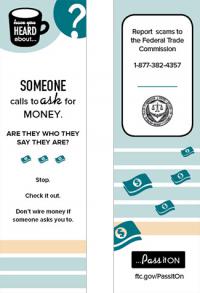 will send you booklets, flyers, bookmarks, and other formats, all concerning consumer education topics, such as internet security, debt, and scams. The publication are available in several languages. Shipping is free. Check out their “Free Publications to Share” at https://bulkorder.ftc.gov/.
will send you booklets, flyers, bookmarks, and other formats, all concerning consumer education topics, such as internet security, debt, and scams. The publication are available in several languages. Shipping is free. Check out their “Free Publications to Share” at https://bulkorder.ftc.gov/.
Posted in Information Resources
Leave a comment
Focus on Nebraska authors: Kent Haruf
Kent Haruf (rhymes with sheriff) graduated from Nebraska Wesleyan University in 1965 where he later taught as an assistant professor. He earned an MFA from the Iowa Writers’ Workshop at the University of Iowa in 1973. These are only a few of his credentials but he came to my attention when his book Plainsong was announced as the very first One Book One Lincoln in 2002. That book marked the beginning of my own book group and a relationship with the One Book One Lincoln program that remains to this day.
Plainsong takes place in the fictional town of Holt, Colorado and is based on the town of Yuma where Mr. Haruf lived in the ‘80s. In a Newsweek review, Jeff Giles called the book “a moving look at our capacity for both pointless cruelty and simple decency, our ability to walk out of the wreckage of one family and build a stronger one where it used to stand.” Many local readers were miffed at the lack of quotation marks throughout the book and this caused a bit of kerfuffle. As I listened to the audio version, it wasn’t an issue. Another Haruf title follows some of the same characters in Holt and is entitled Eventide.
Kent Haruf died at the age of 71 in November of 2014. To honor this writer, you may wish to select some of his titles in our collection: Eventide, Plainsong, The Tie That Binds and Where You Once Belonged
Posted in Books & Reading, General, Information Resources
1 Comment
New Government Publications Received at the Library Commission
 New state government publications have been received at the Nebraska Library Commission for April 2015. Included are titles from Nebraska Colleges and Universities, Nebraska Game & Parks Commission, the Nebraska Fire Marshal and University of Nebraska Press, to name a few.
New state government publications have been received at the Nebraska Library Commission for April 2015. Included are titles from Nebraska Colleges and Universities, Nebraska Game & Parks Commission, the Nebraska Fire Marshal and University of Nebraska Press, to name a few.
How to help in Nepal
I asked Barbara Cornelius, our colleague from Nebraska Wesleyan University for her council on giving to Nepal because she has studied and lived there. Here are the places she recommended:
Verified list of earthquake response initiatives for Nepal http://www.maheshpoudyal.com/nepal-earthquake-25-april-2015/
Manjushree Thapa (Nepali author living in Canada now) tweeted this yesterday: http://www.nytimes.com/live/earthquake-katmandu-nepal-updates/how-to-help-the-relief-effort-in-nepal/
Facebook initiative for International Medical Corps:https://www.facebook.com/nepalearthquakesupport
Posted in General, Information Resources
Leave a comment
The Data Dude – 2014 Survey Data Now Available
 Shaka. The 2014 FY survey data is now available. There are a few different files, all of which can be downloaded here. The complete statistics are available in excel or .csv format. There is also a “Data Dashboard” that summarizes the statistics from the survey. If you notice any errors in your report, please let me know and I will get them corrected. Thank you all for submitting your surveys. Historical data files (back to FY 1999) are also available on the Nebraska Library Commission website.
Shaka. The 2014 FY survey data is now available. There are a few different files, all of which can be downloaded here. The complete statistics are available in excel or .csv format. There is also a “Data Dashboard” that summarizes the statistics from the survey. If you notice any errors in your report, please let me know and I will get them corrected. Thank you all for submitting your surveys. Historical data files (back to FY 1999) are also available on the Nebraska Library Commission website.
See You at the NLA Public Library and Trustee Section Spring Meetings!
Nebraska Library Commission staff look forward to joining Nebraska librarians at the upcoming NE Library Association Public Library and Trustee Section Spring Meetings: April 22 in Alliance, April 23 in Kearney, and April 24 in Columbus. Presenter Valerie Gross, President and CEO of the Howard County Library System in Maryland, will help us examine the strategy of aligning our libraries with the educational mission of our communities to help us tell the story of “Who We Are, What We Do, Why It Matters: Why Nebraska Needs Libraries More than Ever!”
We’ll be staffing a table to share materials to help you reposition your library as a community education resource and your library staff as educators, including:
Books Are Just the Beginning…check out this blog that can direct any Nebraskan to your library and help illustrate the many ways libraries function as educational resources at http://booksarejustthebeginning.com/
Online Self-Directed Education…learn about Skillsoft online classes funded by the Nebraska Library Commission to help train library staff to serve as community educators (http://nlc.nebraska.gov/ce/), United for Libraries (http://www.ala.org/united/nebraska) resources funded by the Nebraska Library Commission for training Trustees/Friends/Foundations, and the Nebraska Library Commission budget request to provide self-directed education programs for all Nebraska residents through their local library (http://nlc.nebraska.gov/stats/online_selfdirected_education_2015.pdf)
Nebraska eReads…pick up materials to tell your community about downloadable eBook and audio book resources (http://nlc.nebraska.gov/stats/eReads.pdf) or print your own at http://nlc.nebraska.gov/overdrive/overdriveinfo.aspx#mm
Nebraska Memories…find out how these digitized historical and cultural resources can illustrate the role of the library in assisting a variety of learners and researchers of all ages, see http://memories.ne.gov/.
NebraskAccess…check out the posters and business cards that you can print with your library password and share with learners in your community to help reinforce the message of how integral libraries are to the community learning environment—customize and print at http://nlc.nebraska.gov/nebraskaccess/promotingdb.aspx
Nebraska Public Libraries are Equalizers…see how statistics can be used to tell the story of how your public library responds to the needs in your community and serves specific target audiences with educational resources, along with instructive and enlightening experiences, see http://nlc.nebraska.gov/stats/general_2015.pdf
NCompass E-Newslist…Keep up with news from the Nebraska Library Commission to help you enhance your library’s visibility by signing up to receive our short weekly email at http://eepurl.com/HSkX
